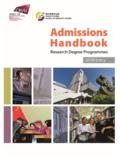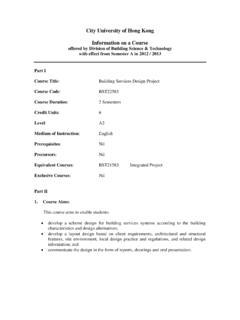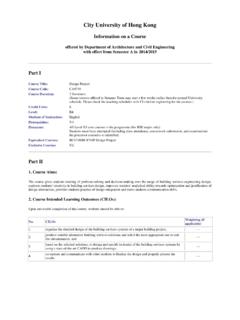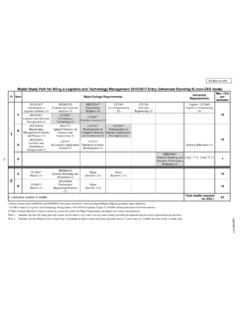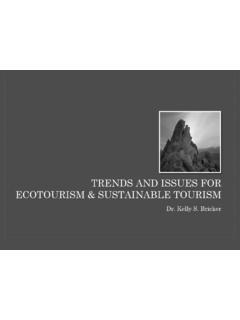Transcription of Preserving the Philippines' Cultural Heritage: Milestones ...
1 Preserving the Philippines' Cultural Heritage: Milestones and Challenges A Lecture on the Philippines' Cultural Heritage Conservation Initiatives and Discussion on Post-Bohol Earthquake and Post-Haiyan Restoration Efforts 19 September 2014, 3:30-5:30 , Hong Kong Visual Arts Centre Theatre By Ivan Anthony S. Henares President, Heritage Conservation Society of the Philippines Secretary, National Committee on Monuments and Sites, National Commission for Culture and the Arts The Cultural heritage of the Republic of the Philippines is a result of the diverse synergy of indigenous agricultural systems, vernacular architecture, historic trade routes, urban planning during the Spanish and American colonial periods, the development of architecture & design for an independent nation.
2 And experiences with natural disasters which the country continues to face today. The country s built heritage also has to face man-made challenges, as policy makers and stakeholders are just beginning to understand the value of heritage conservation to urban development and nation-building. Despite these challenges, there have been successful conservation initiatives across the nation. The Rice Terraces of the Philippine Cordilleras are the country s expression of the balance between man, sacred traditions, agricultural science, and the environment.
3 In recent years, there had been conscientious and systematic efforts to ensure the restoration, conservation and physical rehabilitation of the property. Threats and concerns regarding the property that were identified in 2001, leading to its inclusion in the List of World Heritage in Danger, were addressed by the Provincial Government of Ifugao and government Cultural agencies. After developing better management and planning measures, it was finally removed from the danger list in 2012. Also in 2012, the UNESCO recognized the Historic Town of Vigan during the 40th anniversary of the World Heritage Convention, giving it the Best Practice in World Heritage Management Award.
4 According to the Philippine Government, Vigan was selected for its good management practice with relatively limited resources, local community participation integrated in the various systems of heritage conservation and city management, and the multifaceted approach for the protection of the heritage site. In October 2013, the provinces of Bohol and Cebu were hit by a magnitude earthquake that severely-damaged some of the best examples of Spanish colonial churches, buildings and fortifications in the Philippines. Many of them are National Cultural Treasures and National Historical Landmarks.
5 It was considered the biggest disaster to hit Philippine Cultural heritage since the Second World War. In November 2013, Typhoon Haiyan devastated the Philippines, destroying even more heritage properties in Central Philippines. An inter-agency taskforce was created, composed of the National Commission for Culture and the Arts, National Museum and National Historical Commission of the Philippines, to undertake the long and difficult process of recovery, reconstruction and restoration. Many historic towns and cities are beginning to understand the importance of Preserving built heritage and historic downtowns in urban development.
6 Revitalization efforts in Calle Real (Iloilo City), the Escolta Business District, Santa Ana District, Rizal Park and Intramuros (City of Manila), and the historic centers of Angeles City and the City of San Fernando in Pampanga, Silay City in Negros Occidental, and the Municipality of Taal in Batangas, have become rallying points in the struggle to preserve the built heritage of the Philippines. Page 1 of 2 IVAN ANTHONY HENARES From a very young age, Ivan Anthony Henares has been a staunch advocate for the preservation of Philippine heritage.
7 He is currently President of the Heritage Conservation Society, Expert Member of the ICOMOS International Cultural tourism Committee (ICTC), Trustee of the Nayong Pilipino Foundation and Secretary of the NCCA National Committee on Monuments and Sites. Ivan is a Senior Lecturer at the Asian Institute of tourism of the University of the Philippines, Diliman and the Faculty of Management and Development Studies at UP Open University. He was named one of The Outstanding Young Men (TOYM) for 2012 in the field of Heritage Conservation.
8 Born in 1979 in San Juan, Metro Manila, he completed his elementary and secondary education at the Ateneo de Manila University, and his Bachelor of Arts in Economics, Master of Business Administration and Diploma in Urban and Regional Planning degrees all at the University of the Philippines, Diliman. As a college student, he initiated the Preserving Heritage for Progress Program in the City of San Fernando, Pampanga in 2001, a program that focused on the protection, conservation and promotion of the architectural heritage of the city.
9 He painstakingly convinced local stakeholders to preserve their ancestral homes, many of which were eventually declared by the National Historical Commission of the Philippines as Heritage Houses. In 2004, the program was named Galing Pook Award Trailblazing Program and one of the Top 10 Best Practices of the League of Cities of the Philippines. In 2001, he was named Most Outstanding Kapampangan for Youth Leadership in recognition of his leadership in raising Cultural awareness in Pampanga. In 2005, he received the United Nations Association of the Philippines Outstanding Youth Leader Award.
10 In 2006, he received The Outstanding Fernandino Award for Preservation of Heritage and Promotion of the Arts. In 2007, his blog was named Best Travel Blog at the 1st Philippine Blog Awards. In 2008, he was named a Philippines 21 Fellow by Asia Society, which selects ten promising young leaders every year to join the Asia 21 Young Leaders Summit. In 2010, included him in their list of 10 City Heroes You Should Know for his heritage conservation advocacy. He ably organized the 2012 ICOMOS International Conference on Cultural tourism which brought together Expert Members of ICOMOS from around the world to Vigan, Ilocos Sur to share Cultural tourism best practices to hundreds of local stakeholders.
